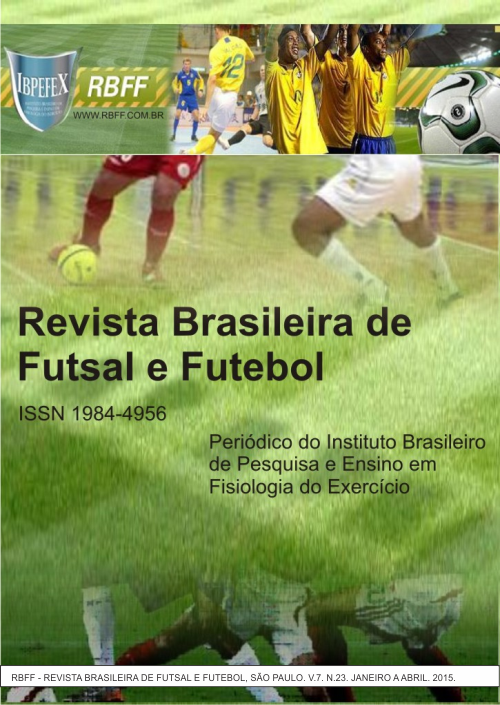The control of intensity of trainings of teams which played the first division of Santa Catarina championship 2013, according to the physical trainers
Abstract
This research aims to investigate how has been done the intensity control of the teams that competed in the Main Division of the Football Championship of Santa Catarina in 2013. The research consisted in the application of a systematic and semi structured interview having twelve questions, applied to six Professional / (of ten) trainers who participated preseason clubs in Santa Catarina, emphasizing ways to control of intensity in training. The data were processed and categorized by content analysis. After the assessment of the interviews, we conclude that the current football schedule appears as an enemy in the physical preparation of athletes, because the time for physical training has been reduced, thus inducing the intense workout. We realized that the emphasis on controlling the intensity is directly focused on the specificity of motor gestures of football according to biological individuality and physiologic of each athlete, for keeping always in a better fitness level. In Santa Catarina, hegemonically, football professionals perform control of the training according to the structure and financial condition of the club. The most common methods used among professionals of this state are controlling the heart rate, Borg scale, GPS, body composition and feeling, talk to the athlete after training targeting to report how is the feeling physically. It is noticed that the Football in Santa Catarina needs important tools that enable a more qualified organization in training for developing of higher performance of athletes.
References
-Arruda, M. Treinamento para jovens futebolistas. Phorte. 2010.
-Bangsbo, J. The physiology of the soccer, with special reference to intense intermittent exercise. Acta Physiologica Scandinavica. Supplementum, Vol. 619. p. 151-155. 1994.
-Bangsbo, J.; Mohr, M.; Krustrup, P. Physical and metabolic demands of training and match-play in the elite football player. Journal Sports Sciences. Vol. 24, Num. 7, p. 665-674, 2006.
-Bompa, T.; Cornacchia, L. J. Treinamento de força consciente: estratégias para ganho de massa muscular. Phorte. 1993.
-Bompa, T. Periodização: Teoria de metodologia do treinamento. Phorte. 2001.
-Bompa, T. Periodização: Teoria e Metodologia do Treinamento. Phorte. 2002.
-Borin, J. P.; Gomes, A. C.; Leite, G. Preparação Desportiva: Aspectos do Controle da Carga de Treinamento nos Jogos Coletivos. Revista da Educação Física. Vol. 18. p. 97-105. 2007.
-Ferreira, J. C.; Szmuchrowski, L. A. Sistema de monitoramento e controle da carga de treinamento. Laboratório Olímpico. Informativo técnico-científico do comitê olímpico brasileiro. Num. 7.2008.
-FIFA. Federation Internationale de Football Association. Disponível em: < www.fifa.com/en/marketing/concept/index/0,1304,22,00.html >. Acessado em: 02/02/2013.
-Forteza de La Rosa, A. Treinamento desportivo: carga, estrutura e planejamento. Phorte. 2001.
-Forteza de La Rosa, A. Treinamento desportivo: carga, estrutura e planejamento. São Paulo. Phorte. 2006.
-Gil, A. C. Métodos e técnicas de pesquisa social. Atlas. 1999.
-Gomes, A. C. Treinamento Desportivo: estruturação e periodização. Artmed. 2002.
-Gomes, A. C. Carga de Treinamento nos Esportes. Londrina, Sport Training. 2010.
-Gomes, A. C.; Souza, J. Futebol: treinamento desportivo de alto rendimento.Artmed.2008.
-Helgerud, J.; Engen, L. C.; Wisloff, U.; Hoff, J. Aerobic endurance training improves soccer performance. Medicine and Science in Sports and Exercise. Vol. 33. Num. 11. p. 1925-1931. 2001.
-Nakasone, H. H; Junior, J. M; Aquino, S. S. A importância da experiência profissional na ótica dos operários: survey em sistemas produtivos do setor vidreiro. In: XXX Encontro Nacional de Engenharia de Produção. São Carlos. Brasil. 2010.
-Reilly, T. Energetics of high-intensity exercise (soccer) with particular reference to fadigue. Journal of Sports Sciences. Vol. 15. p. 257-263. 1997.
-Tubino, M. J. G. Metodologia científica do treinamento desportivo. Ibrasa. 1984.
-Verkhoshanski, Y. V. Principles for a rational organization of the training process aimed at speed development. Revista Treinamento Desportivo. Vol. 4. Num. 1. p. 3-7. 1999.
-Verkhoshansky, Y. V. Entrenamiento deportivo: planificación yprogramación. Barcelona. Martínez Roca. 1990.
-Weineck, J. Treinamento Ideal. Manole. 2003.
-Weineck, J. Futebol Total: O Treinamento Físico no Futebol. São Paulo. Shape. 2000.
-Zakharov, A.; Gomes, A. C. Ciência do treinamento desportivo. Grupo Palestra Sport. 2003.
Authors who publish in this journal agree to the following terms:
- Authors retain the copyright and grant the journal the right of first publication, with work simultaneously licensed under the Creative Commons Attribution License BY-NC which allows the sharing of the work with acknowledgment of the authorship of the work and initial publication in this journal.
- Authors are authorized to enter into additional contracts separately for non-exclusive distribution of the version of the work published in this journal (eg, publishing in institutional repository or book chapter), with acknowledgment of authorship and initial publication in this journal.
- Authors are allowed and encouraged to post and distribute their work online (eg, in institutional repositories or on their personal page) at any point before or during the editorial process, as this can bring about productive change as well as increase impact and impact. citation of published work (See The Effect of Free Access).





